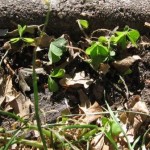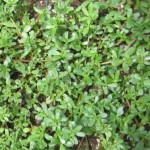Archive for Eating Locally
Free Food!
Posted by: | CommentsAs some of you may know, I am also an Urban Forager and lead wild edible walks in the city neighborhoods. This is the time of year when all sorts of lovely spring greens are available for picking. Gathering the greens for dinner used to be considered part of the walk home from work, and included dandelions, dock, lambs quarters, and various flowers. Depending on the location, other herbs and ‘weeds’ were also available.
As kids we knew about eating the greens we found as we roamed. Slip the thin grass blades of timothy, wild oats, and rye grass from their stems and chew the ends to get some energy. Nibble on ‘sour grass’ or ‘pickle plant’ (Oxalis acetosa) for a lemony taste; use wild mint to add a good flavor to the mouth and aid the stomach. As time passed, we lost touch with the delicious goodness of these wild treats, somehow relegating them to a category of awful pests and weeds to be eliminated. I have a better suggestion: eat these nutritious little goodies after you pull them out of the garden!
One I am particularly fond of is purslane. It looks like a low-growing jade plant, spreading itself over the ground around the plants. I use it as a mulch to retain moisture on my sandy soil, and when there is too much nothing could be simpler to pull than this shallow rooted plant. It contains more omega 3 fatty acids than any other plant I’ve heard of, more than most fish, and can be used so many different ways: raw, sauteed, stewed, stir-fried, pickled, and if you have backyard chickens this is a great way to increase the omega 3 content in their eggs.
Many other cultures use purslane as a vegetable and sell it at the farmers market. I did find it in Ojai, CA at their farmers market! Maybe the local markets will have it soon along with dandelion greens and burdock roots. But why pay for these little goodies? They are there for the taking.
Just be aware and conscious of where you pick them! Make sure the area has not been sprayed with herbicide. You can tell if it has been sprayed if there is a mono-culture (only one type of plant), if the dandelions look stunted, strangely shaped, weirdly wilted, or there are those little flags present. Also, ASK! Don’t pick next to a busy street or thruway. Don’t pick where nothing much is growing, in old parking lots, or in industrial areas.
Also only use the wild edibles for less than half of a salad or cooked dish since they are generally much stronger than the veggies you buy at the store. They won’t hurt you but the idea is to enjoy them, not be overwhelmed by their exotic taste. These plants also will help you detoxify your body, and you want that to be gentle as well. Most of all, have a good time examining these tasty treats, add them to your diet slowly, learn your likes and dislikes, and NEVER eat any plant you do not know!! The library is a valuable resource and has many books on wild edibles. Now there are people like myself in most cities that will teach you about your sources and varieties of free food!
Next Step for Clean Food
Posted by: | CommentsLet’s look at another way to make healthy changes in the way we eat. This time we are going to focus on what is essential in our diet, and which items are just plain dangerous. What things do we need to have as a part of our meals and how does this look when we get to the grocery store?
If we reduce the grocery list to the bare essentials it could look like this: vegetables, fruit, protein, grains, seeds, nuts, and dairy. Paper products, cleaning products, and personal hygiene products are not foods, so they are a separate expense, and just for the moment we will take them off the grocery list.
When we get back to basics, the handiest way to get there is to use a menu. You don’t have to make them up yourself; you can find endless menus on line. The advantage of making them up yourself is taking into consideration your families likes and dislikes, needs and eating patterns. Some people need 6 small meals a day – more like a series of snacks – and another person likes 3 meals a day. You get the idea. Another thought…eat less of everything to reduce your food bill. In America, we are sending 40% of the food we grow to the landfill! So waste not; want not!
Let’s get into why I buy foods that fill a specific criterion. Let’s take one typical breakfast as an example. I am a person who needs protein and good fats in the morning or I am fading away by 10 am. Some days I have an egg (free range, vegetarian feed, no antibiotics), with mushrooms or green onions and cheese (no rBST), a piece of organic whole grain toast and butter with a little local, raw honey. Why the specific types of each ingredient? Read on…
Eggs from factory farms are not good for you. The hens are stressed so their eggs have high LDL cholesterol, and also antibiotics. The free range hens that are fed a diet high in grains, or better yet can forage outside, and don’t need antibiotics because they are not packed together tightly, give us eggs that are much lower in LDL cholesterol and much higher in HDL (or good) cholesterol. Stressed, unhealthy hens = unhealthy eggs. The original research on eggs being high in ‘bad’ cholesterol came from factory farms.
Let’s look at bread now. Bread never used to have ingredients we couldn’t grow and couldn’t pronounce. Most breads had whole ground grains, yeast or starter, water, salt, and maybe an oil. It was that simple. It was made fresh and sold fresh, so no preservatives were needed. We can still get bread like that. However there is one more problem now. If the ingredient list contain any corn products, any soy products, and/or any canola oil, (and is not organic) you are eating a Genetically Modified Organism (GMO) which contains pesticides in every cell. I can find bread that is ‘clean’ and not organic in most supermarkets; however it is just as cost effective to buy organic bread on sale and freeze it. Are you getting the idea? Local raw honey is good for me and helps protect me from local pollen allergies if I have a teaspoon or so a day.
If we simply cut out the foods that, as Michael Pollan says, are “food-like substances”, we will decrease our food bills even if all the other foods we buy are clean and/or organic and more expensive. We will also decrease our medical bills. Here is a list of the “dirty dozen” foods no one should buy unless they are organic because of pesticide residue: Apples, Bell Peppers, Celery, Cherries, Imported Grapes, Nectarines, Peaches, Pears, Potatoes, Raspberries, Spinach, and Strawberries. If it is too expensive, buy on sale or have as a treat. If you want more information on these and other best green practices go to www.GreenAmericaToday.org or other similar websites.
So the key concepts to changing the way we eat might be summed up this way: simplify; buy and eat whole foods; learn how to cook them; read the labels and avoid GMO’s; and beware of all the toxins in prepared foods! (www.care2.com/causes/study-finds-arsenic-in-baby-formula-and-cereal-bars.html)


